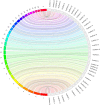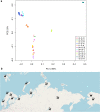Whole-genome sequencing provides novel insights into the evolutionary history and genetic adaptation of reindeer populations in northern Eurasia
- PMID: 38155192
- PMCID: PMC10754820
- DOI: 10.1038/s41598-023-50253-7
Whole-genome sequencing provides novel insights into the evolutionary history and genetic adaptation of reindeer populations in northern Eurasia
Abstract
Domestic reindeer (Rangifer tarandus) play a vital role in the culture and livelihoods of indigenous people across northern Eurasia. These animals are well adapted to harsh environmental conditions, such as extreme cold, limited feed availability and long migration distances. Therefore, understanding the genomics of reindeer is crucial for improving their management, conservation and utilisation. In this study, we have generated a new genome assembly for the Fennoscandian domestic reindeer with high contiguity, making it the most complete reference genome for reindeer to date. The new genome assembly was utilised to explore genetic diversity, population structure and selective sweeps in Eurasian Rangifer tarandus populations which was based on the largest population genomic dataset for reindeer, encompassing 58 individuals from diverse populations. Phylogenetic analyses revealed distinct genetic clusters, with the Finnish wild forest reindeer (Rangifer tarandus fennicus) standing out as a unique subspecies. Divergence time estimates suggested a separation of ~ 52 thousand years ago (Kya) between the northern European Rangifer tarandus fennicus and Rangifer tarandus tarandus. Our study identified four main genetic clusters: Fennoscandian, the eastern/northern Russian and Alaskan group, the Finnish forest reindeer, and the Svalbard reindeer. Furthermore, two independent reindeer domestication processes were inferred, suggesting separate origins for the domestic Fennoscandian and eastern/northern Russian reindeer. Notably, shared genes under selection, including retroviral genes, point towards molecular domestication processes that aided adaptation of this species to diverse environments.
© 2023. The Author(s).
Conflict of interest statement
The authors declare no competing interests.
Figures





Similar articles
-
Osteometric distinctions between domestic reindeer (Rangifer tarandus tarandus), wild mountain reindeer (R.t.t.), wild forest reindeer (R.t. fennicus), and the identification of castrated reindeer bones: Biometric explorations and archaeological methods.Archaeol Anthropol Sci. 2025;17(4):94. doi: 10.1007/s12520-025-02198-3. Epub 2025 Apr 1. Archaeol Anthropol Sci. 2025. PMID: 40183003 Free PMC article.
-
Genome sequence and comparative analysis of reindeer (Rangifer tarandus) in northern Eurasia.Sci Rep. 2020 Jun 2;10(1):8980. doi: 10.1038/s41598-020-65487-y. Sci Rep. 2020. PMID: 32488117 Free PMC article.
-
Mitochondrial DNA and microsatellite DNA variation in domestic reindeer (Rangifer tarandus tarandus) and relationships with wild caribou (Rangifer tarandus granti, Rangifer tarandus groenlandicus, and Rangifer tarandus caribou).J Hered. 2006 Sep-Oct;97(5):525-30. doi: 10.1093/jhered/esl012. Epub 2006 Jul 12. J Hered. 2006. PMID: 16837563
-
Pestivirus infection in reindeer (Rangifer tarandus).Front Microbiol. 2015 Oct 26;6:1187. doi: 10.3389/fmicb.2015.01187. eCollection 2015. Front Microbiol. 2015. PMID: 26579094 Free PMC article. Review.
-
Gastrointestinal parasites in reindeer (Rangifer tarandus tarandus): A review focusing on Fennoscandia.Vet Parasitol Reg Stud Reports. 2019 Aug;17:100317. doi: 10.1016/j.vprsr.2019.100317. Epub 2019 Jun 20. Vet Parasitol Reg Stud Reports. 2019. PMID: 31303237 Review.
Cited by
-
Genetic advancements and future directions in ruminant livestock breeding: from reference genomes to multiomics innovations.Sci China Life Sci. 2025 Apr;68(4):934-960. doi: 10.1007/s11427-024-2744-4. Epub 2024 Nov 26. Sci China Life Sci. 2025. PMID: 39609363 Review.
-
Inferences about the population history of Rangifer tarandus from Y chromosome and mtDNA phylogenies.Ecol Evol. 2024 Jun 10;14(6):e11573. doi: 10.1002/ece3.11573. eCollection 2024 Jun. Ecol Evol. 2024. PMID: 38863721 Free PMC article.
-
Oar_Finn: the genome assembly and annotation of an exceptionally fertile Finnsheep (Ovis aries) Ewe.BMC Genom Data. 2025 Aug 19;26(1):59. doi: 10.1186/s12863-025-01354-x. BMC Genom Data. 2025. PMID: 40826014 Free PMC article.
-
Polymorphism of Genes Potentially Affecting Growth and Body Size Suggests Genetic Divergence in Wild and Domestic Reindeer (Rangifer tarandus) Populations.Genes (Basel). 2024 Dec 20;15(12):1629. doi: 10.3390/genes15121629. Genes (Basel). 2024. PMID: 39766896 Free PMC article.
References
-
- Pelletier M, Kotiaho A, Niinimäki S, Salmi A-K. Identifying early stages of reindeer domestication in the archaeological record: A 3D morphological investigation on forelimb bones of modern populations from Fennoscandia. Archaeol. Anthropol. Sci. 2020;12:169. doi: 10.1007/s12520-020-01123-0. - DOI - PMC - PubMed
-
- Anderson DG, Kvie KS, Davydov VN, Røed KH. Maintaining genetic integrity of coexisting wild and domestic populations: Genetic differentiation between wild and domestic Rangifer with long traditions of intentional interbreeding. Ecol. Evol. 2017;7:6790–6802. doi: 10.1002/ece3.3230. - DOI - PMC - PubMed
-
- Iacolina L, Corlatti L, Buzan E, Safner T, Šprem N. Hybridisation in European ungulates: An overview of the current status, causes, and consequences. Mammal Rev. 2019;49:45–59. doi: 10.1111/mam.12140. - DOI
MeSH terms
Grants and funding
LinkOut - more resources
Full Text Sources

